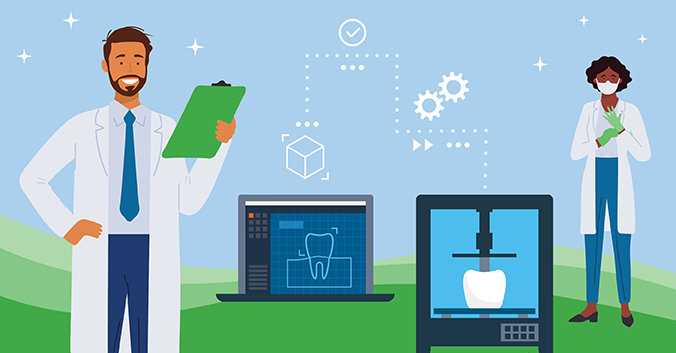
5 tech trends to watch in 2023
It seems like every day there’s a new groundbreaking technological advancement being announced, from images generated by artificial intelligence to energy produced by nuclear fusion. Luckily, the field of dentistry has its own fair share of tech marvels! These are the five dental tech trends we’re keeping an eye on in 2023.
1. Digital models and 3D printing
There are several applications for using digital and physical 3D models in dentistry. With these models, dentists can see the inside of their patient’s mouth with more clarity for diagnostics than what’s provided by traditional model work and articulators. They can be used as presurgical guides to help you make the best decisions to address patients’ needs.
3D models may also be helpful at reducing surgical times and trauma when used to plan operations, according to a study in the Journal of Stomatology, Oral and Maxillofacial Surgery. Dentists can use digital models and 3D printing to create implant guides, molds, veneers and aligners. 3D prints can also be used to help patients visualize their treatment as you explain it to them.
One newer benefit of 3D printing is that costs have dropped while material quality has increased in the past decade. If you’re interested in exploring 3D printing in your practice, decent 3D printers for small items can cost as little as $200, and great printers can be purchased for between $500 and $1,000. The material used for printing, called filament, is an additional cost to keep in mind.
There can be a steep learning curve to using digital models and 3D printing, but there are plenty of communities on the internet to help you troubleshoot.
2. Cone-beam computed tomography (CBCT) scans
CBCT imaging is one way for dentists to get the information needed to build digital models. The imaging scanners make a full or partial circular revolution around the patient and take a sequence of 2D x-ray images. Those x-rays are reconstructed on a computer to display a 3D model that can be viewed in many ways, including cross-sections or close ups of oral anatomy. Once the model exists, you can see dentition, soft tissues, nerve pathways and facial bones all in one comprehensive record.
CBCT scans are becoming the standard for care in orthodontics and oral surgery, and their popularity is increasing for endodontics and general practice diagnostics. Dentists who use CBCT scanners must receive the appropriate training for safe use of the machines.
3. Intraoral scanners
Intraoral scanners are handheld tools used to collect data for digital impressions, similar to CBCT scans. The scanners are usually in the form of a large wand that you hold in your patient’s mouth for one to two minutes. That means they’re faster than traditional impressions and more comfortable for patients. They don’t capture the same amount of data as a CBCT scanner because intraoral scanners use digital sensors instead of x-ray. They’re still very accurate and are helpful for tooth- and implant-supported crowns or short-span fixed dental prostheses, but scans for larger sets of crowns or dentures may be problematic.
4. Artificial intelligence
In 2022, the FDA cleared the first artificial intelligence (AI) powered auto-charting product to help dental professionals interpret intraoral and extraoral 2D x-ray images by automatically detecting and numbering intact and missing teeth. In their report to clear that product, the FDA determined that it showed a 70% reduction in time and effort spent on creating dental charts.
But charting isn’t the only application for AI. One study published by Cureus, predicted many different possible applications in different fields. Suggested use cases include determining working length for root canal treatments, detecting root fractures, orthodontic planning and monitoring, and intraoperative surgeries.
5. Robot assistants
The future of dentistry may include a lot of robots. This year, the FDA gave clearance for a company to use a dental robot for bone reduction in dental implant surgery. The robotic system helps dentists during the preoperative and intraoperative phases of surgery by performing robot-guided bone reduction of the mandible and maxilla.
Microrobots could also be used to access difficult-to-reach areas of the root canal to treat biofilms, deliver drugs and retrieve diagnostic samples, according to a study published in the Journal of Dental Research. Researchers were able to track the robots’ movements in real time using imaging technology like intraoral scanners, dental x-rays and cone-beam computed tomography.
Recent posts
- Prepare your practice for back-to-school season
- Delta Dental is partnering with dental schools to offer exclusive CE courses
- Drive better patient experiences with benefit conversations
- Offer care beyond the chair with teledentistry
- Healthy mouths begin with hygienists
- How to educate patients and make them partners in oral health
- Dr. Justin Perdichizzi — serving those who served
- Get your patients to make (and keep) their dental appointments
- One sign-on, many advantages
- Delta Dental hosts in-person Provider Advisory Council in Arizona
